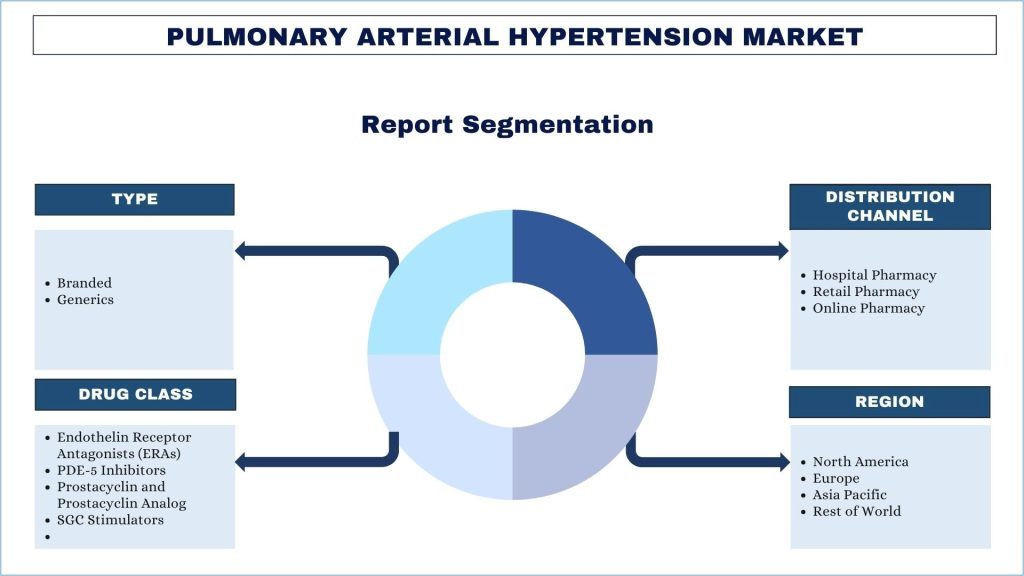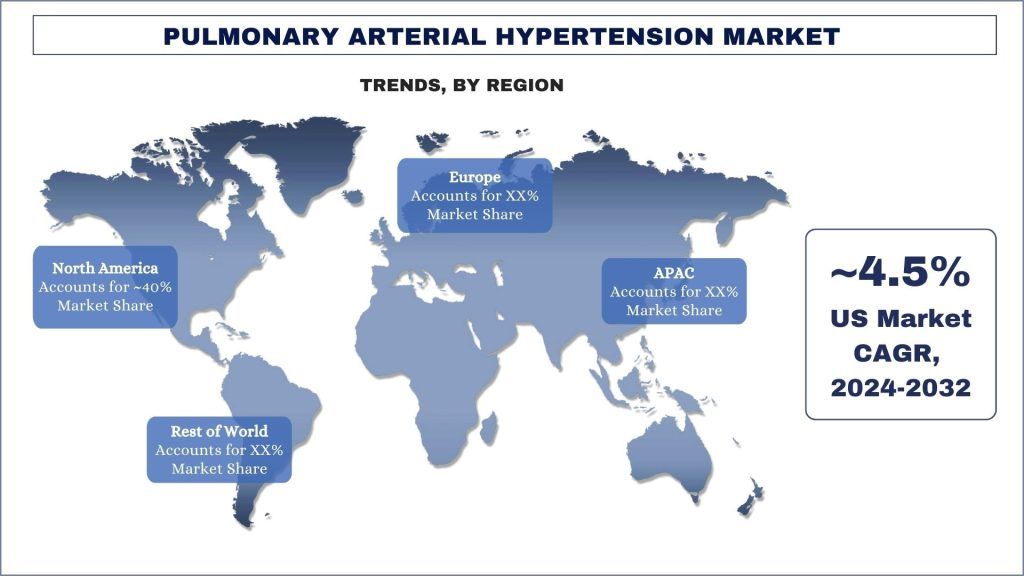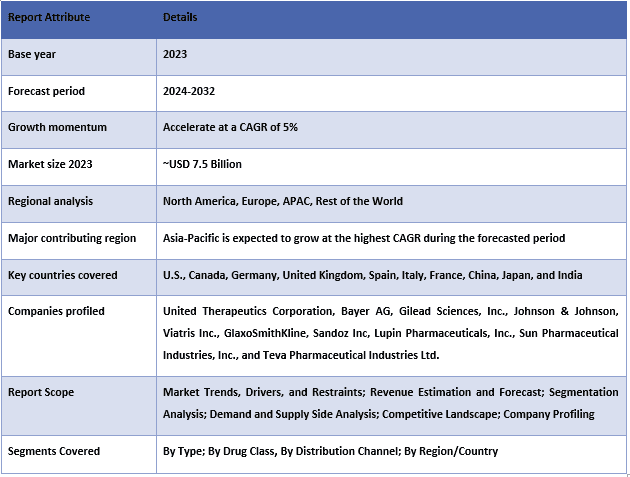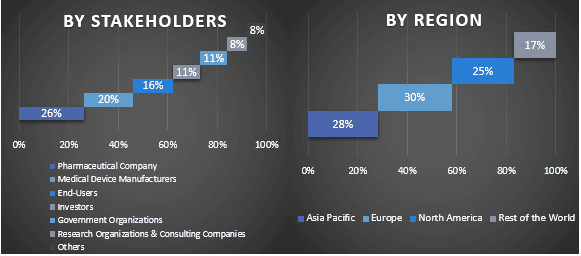- الرئيسية
- معلومات عنا
- صناعة
- الخدمات
- قراءة
- اتصل بنا
سوق ارتفاع ضغط الدم الرئوي: التحليل الحالي والتوقعات (2024-2032)
التركيز على النوع (ذو العلامة التجارية والأدوية الجنيسة)؛ فئة الدواء (مضادات مستقبلات الإندوثيلين (ERAs)، مثبطات PDE-5، البروستاسيكلين ونظائر البروستاسيكلين، ومنبهات SGC)، قناة التوزيع (صيدلية المستشفى، صيدلية البيع بالتجزئة، والصيدلية الإلكترونية)؛ والمنطقة/الدولة

حجم سوق ارتفاع ضغط الدم الرئوي الشرياني والتوقعات
بلغت قيمة سوق ارتفاع ضغط الدم الرئوي الشرياني ما يقرب من 7.5 مليار دولار أمريكي في عام 2023 ومن المتوقع أن ينمو بمعدل نمو سنوي مركب قوي يبلغ حوالي 5٪ خلال الفترة المتوقعة (2024-2032) بسبب ارتفاع حالات ارتفاع ضغط الدم الرئوي الشرياني.
تحليل سوق ارتفاع ضغط الدم الرئوي الشرياني
يعد ارتفاع ضغط الدم الرئوي الشرياني (PAH) اضطرابًا نادرًا وتدريجيًا يتميز بارتفاع ضغط الدم في الشرايين الرئوية، التي تحمل الدم من القلب إلى الرئتين. تؤدي هذه الحالة إلى تضييق وتصلب هذه الشرايين، مما يتسبب في زيادة مقاومة تدفق الدم وبالتالي وضع ضغط إضافي على الجانب الأيمن من القلب. مع مرور الوقت، يمكن أن يؤدي ارتفاع ضغط الدم الرئوي الشرياني إلى فشل القلب الأيمن ومضاعفات خطيرة أخرى. تشمل الأعراض عادةً ضيق التنفس والتعب وألم في الصدر والدوخة والتورم في الساقين والكاحلين. يمكن أن يكون ارتفاع ضغط الدم الرئوي الشرياني مجهول السبب أو وراثيًا أو مرتبطًا بأمراض أخرى مثل اضطرابات النسيج الضام أو أمراض القلب الخلقية أو أمراض الكبد المزمنة. إن زيادة الإصابة بارتفاع ضغط الدم الرئوي الشرياني تدفع السوق. على سبيل المثال، وفقًا لبيانات جمعية القلب الأمريكية (AHA) لعام 2021، يقدر انتشار ارتفاع ضغط الدم الرئوي الشرياني في الولايات المتحدة بين 15 و 50 حالة لكل مليون شخص، مع حدوث حوالي 2-5 حالات لكل مليون بالغ سنويًا.

اتجاهات سوق ارتفاع ضغط الدم الرئوي الشرياني
يناقش هذا القسم اتجاهات السوق الرئيسية التي تؤثر على القطاعات المختلفة لسوق ارتفاع ضغط الدم الرئوي الشرياني كما حددها فريق خبراء الأبحاث لدينا.
تزايد الطلب على الأساليب العلاجية المبتكرة
تعمل التطورات في أنظمة توصيل الأدوية، مثل التوصيل القائم على الجسيمات النانوية والتركيبات القابلة للاستنشاق، على تحسين فعالية وسلامة علاجات ارتفاع ضغط الدم الرئوي الشرياني. تسمح هذه الأنظمة بالتوصيل المستهدف للأدوية مباشرة إلى الرئتين، مما يعزز النتائج العلاجية ويقلل من الآثار الجانبية الجهازية. علاوة على ذلك، تحمل أساليب العلاج الجيني والخلايا الناشئة وعودًا بعلاج ارتفاع ضغط الدم الرئوي الشرياني على المستوى الجزيئي. تهدف تقنيات مثل تعديل الجينات والعلاج بالخلايا الجذعية إلى إصلاح أو استبدال خلايا الشريان الرئوي التالفة، مما يوفر حلولًا محتملة طويلة الأجل لمرضى ارتفاع ضغط الدم الرئوي الشرياني.

من المتوقع أن تنمو أمريكا الشمالية بمعدل نمو سنوي مركب كبير خلال الفترة المتوقعة
شهد سوق ارتفاع ضغط الدم الرئوي الشرياني في أمريكا الشمالية نموًا كبيرًا في السنوات الأخيرة، مدفوعًا بعوامل مختلفة. تمثل أمريكا الشمالية، وخاصة الولايات المتحدة، أحد أكبر الأسواق لارتفاع ضغط الدم الرئوي الشرياني على مستوى العالم. أحد المحركات الأساسية لسوق ارتفاع ضغط الدم الرئوي الشرياني في أمريكا الشمالية هو ارتفاع حالات ارتفاع ضغط الدم الرئوي الشرياني وزيادة تبني التقنيات الرقمية والتطبيب عن بعد. تتيح الأجهزة القابلة للارتداء وتطبيقات الصحة المحمولة المراقبة المستمرة عن بعد لمرضى ارتفاع ضغط الدم الرئوي الشرياني. يمكن لهذه التقنيات تتبع العلامات الحيوية والنشاط البدني والأعراض في الوقت الفعلي، مما يسمح بالكشف المبكر عن تفاقم المرض والتدخل في الوقت المناسب.
نظرة عامة على صناعة ارتفاع ضغط الدم الرئوي الشرياني
سوق ارتفاع ضغط الدم الرئوي الشرياني تنافسي، مع وجود العديد من اللاعبين في السوق العالميين والدوليين. يتبنى اللاعبون الرئيسيون استراتيجيات نمو مختلفة لتعزيز وجودهم في السوق، مثل الشراكات والاتفاقيات والتعاون وإطلاق المنتجات الجديدة والتوسعات الجغرافية وعمليات الاندماج والاستحواذ. بعض اللاعبين الرئيسيين العاملين في السوق هم United Therapeutics Corporation و Bayer AG و Gilead Sciences, Inc. و Johnson & Johnson و Viatris Inc. و GlaxoSmithKline و Sandoz Inc و Lupin Pharmaceuticals, Inc. و Sun Pharmaceutical Industries, Inc. و Teva Pharmaceutical Industries Ltd.
تغطية تقرير سوق ارتفاع ضغط الدم الرئوي الشرياني

أسباب شراء هذا التقرير:
- تتضمن الدراسة تحليل حجم السوق والتنبؤ به والذي تم التحقق من صحته بواسطة خبراء الصناعة الرئيسيين الموثوقين.
- يقدم التقرير مراجعة سريعة للأداء العام للصناعة في لمحة.
- يغطي التقرير تحليلًا متعمقًا لأقران الصناعة البارزين مع التركيز الأساسي على البيانات المالية الرئيسية للأعمال ومحافظ المنتجات واستراتيجيات التوسع والتطورات الأخيرة.
- دراسة تفصيلية للمحركات والقيود والاتجاهات الرئيسية والفرص السائدة في الصناعة.
- تغطي الدراسة بشكل شامل السوق عبر مختلف القطاعات.
- تحليل متعمق على المستوى الإقليمي للصناعة.
خيارات التخصيص:
يمكن زيادة تخصيص سوق ارتفاع ضغط الدم الرئوي الشرياني العالمي وفقًا للمتطلبات أو أي قطاع آخر في السوق. إلى جانب ذلك، تتفهم UMI أن لديك احتياجات عمل خاصة بك، لذا لا تتردد في التواصل معنا للحصول على تقرير يناسب متطلباتك تمامًا.
جدول المحتويات
منهجية البحث لتحليل سوق ارتفاع ضغط الدم الشرياني الرئوي (2024-2032)
كان تحليل السوق التاريخي، وتقدير السوق الحالي، والتنبؤ بالسوق المستقبلي لسوق ارتفاع ضغط الدم الشرياني الرئوي العالمي هي الخطوات الرئيسية الثلاث التي اتخذت لإنشاء وتحليل اعتماد ارتفاع ضغط الدم الشرياني الرئوي في المناطق الرئيسية على مستوى العالم. أُجري بحث ثانوي شامل لجمع أرقام السوق التاريخية وتقدير حجم السوق الحالي. ثانيًا، للتحقق من صحة هذه الأفكار، أُخذت العديد من النتائج والافتراضات في الاعتبار. علاوة على ذلك، أُجريت مقابلات أولية شاملة أيضًا مع خبراء الصناعة عبر سلسلة القيمة لسوق ارتفاع ضغط الدم الشرياني الرئوي العالمي. بعد افتراض أرقام السوق والتحقق من صحتها من خلال المقابلات الأولية، استخدمنا نهجًا من أعلى إلى أسفل / من أسفل إلى أعلى للتنبؤ بحجم السوق الكامل. بعد ذلك، اعتُمدت طرق تقسيم السوق وتثليث البيانات لتقدير وتحليل حجم سوق القطاعات والقطاعات الفرعية المتعلقة بالصناعة. تم شرح المنهجية التفصيلية أدناه:
تحليل حجم السوق التاريخي
الخطوة 1: دراسة متعمقة للمصادر الثانوية:
أُجريت دراسة ثانوية تفصيلية للحصول على حجم السوق التاريخي لسوق ارتفاع ضغط الدم الشرياني الرئوي من خلال مصادر داخلية للشركة مثل التقارير السنوية والبيانات المالية وعروض الأداء والنشرات الصحفية وما إلى ذلك، ومصادر خارجية بما في ذلك المجلات والأخبار والمقالات والمنشورات الحكومية ومنشورات المنافسين وتقارير القطاعات وقاعدة بيانات الطرف الثالث والمنشورات الموثوقة الأخرى.
الخطوة 2: تقسيم السوق:
بعد الحصول على حجم السوق التاريخي لسوق ارتفاع ضغط الدم الشرياني الرئوي، أجرينا تحليلًا ثانويًا تفصيليًا لجمع رؤى السوق التاريخية ومشاركتها للقطاعات والقطاعات الفرعية المختلفة للمناطق الرئيسية. يتم تضمين القطاعات الرئيسية في التقرير كنوع، وفئة الأدوية، وقناة التوزيع والمناطق. علاوة على ذلك، أُجريت تحليلات على مستوى الدولة لتقييم الاعتماد الكلي لنماذج الاختبار في تلك المنطقة.
الخطوة 3: تحليل العوامل:
بعد الحصول على حجم السوق التاريخي للقطاعات والقطاعات الفرعية المختلفة، أجرينا تحليلًا تفصيليًا للعوامل لتقدير حجم السوق الحالي لسوق ارتفاع ضغط الدم الشرياني الرئوي. علاوة على ذلك، أجرينا تحليلًا للعوامل باستخدام متغيرات تابعة ومستقلة مثل النوع وفئة الأدوية وقناة التوزيع ومناطق سوق ارتفاع ضغط الدم الشرياني الرئوي. أُجري تحليل شامل لسيناريوهات جانب الطلب والعرض مع الأخذ في الاعتبار أهم الشراكات وعمليات الاندماج والاستحواذ والتوسع التجاري وإطلاق المنتجات في قطاع سوق ارتفاع ضغط الدم الشرياني الرئوي في جميع أنحاء العالم.
تقدير حجم السوق الحالي والتوقعات
تحديد حجم السوق الحالي: بناءً على رؤى قابلة للتنفيذ من الخطوات الثلاث المذكورة أعلاه، توصلنا إلى حجم السوق الحالي واللاعبين الرئيسيين في سوق ارتفاع ضغط الدم الشرياني الرئوي العالمي والحصص السوقية للقطاعات. تم تحديد جميع تقسيمات الحصص المئوية المطلوبة وتقسيمات السوق باستخدام النهج الثانوي المذكور أعلاه وتم التحقق منها من خلال المقابلات الأولية.
التقدير والتنبؤ: لتقدير السوق والتنبؤ به، تم تعيين أوزان لعوامل مختلفة بما في ذلك المحركات والاتجاهات والقيود والفرص المتاحة لأصحاب المصلحة. بعد تحليل هذه العوامل، تم تطبيق تقنيات التنبؤ ذات الصلة، أي النهج من أعلى إلى أسفل / من أسفل إلى أعلى للتوصل إلى توقعات السوق لعام 2032 للقطاعات والقطاعات الفرعية المختلفة عبر الأسواق الرئيسية على مستوى العالم. تشمل منهجية البحث المعتمدة لتقدير حجم السوق:
- حجم سوق الصناعة، من حيث الإيرادات (بالدولار الأمريكي) ومعدل اعتماد سوق ارتفاع ضغط الدم الشرياني الرئوي عبر الأسواق الرئيسية محليًا
- جميع الحصص المئوية والتقسيمات والتحليلات التفصيلية لقطاعات السوق وقطاعاته الفرعية
- اللاعبون الرئيسيون في سوق ارتفاع ضغط الدم الشرياني الرئوي العالمي من حيث المنتجات المعروضة. أيضًا، استراتيجيات النمو التي يتبناها هؤلاء اللاعبون للمنافسة في السوق سريع النمو.
التحقق من صحة حجم السوق وحصته
البحث الأولي: أُجريت مقابلات متعمقة مع قادة الرأي الرئيسيين (KOLs) بما في ذلك كبار المديرين التنفيذيين (CXO/VPs، رئيس المبيعات، رئيس التسويق، الرئيس التشغيلي، الرئيس الإقليمي، رئيس الدولة، وما إلى ذلك) عبر المناطق الرئيسية. ثم تم تلخيص نتائج البحث الأولي، وأُجري تحليل إحصائي لإثبات الفرضية المذكورة. تم دمج مدخلات البحث الأولي مع النتائج الثانوية، وبالتالي تحويل المعلومات إلى رؤى قابلة للتنفيذ.
تقسيم المشاركين الرئيسيين في المناطق المختلفة

هندسة السوق
استُخدمت تقنية تثليث البيانات لإكمال تقدير السوق الكلي والتوصل إلى أرقام إحصائية دقيقة لكل قطاع وقطاع فرعي من سوق ارتفاع ضغط الدم الشرياني الرئوي العالمي. تم تقسيم البيانات إلى عدة قطاعات وقطاعات فرعية بعد دراسة مختلف المعلمات والاتجاهات في مجالات النوع وفئة الأدوية وقناة التوزيع والمناطق في سوق ارتفاع ضغط الدم الشرياني الرئوي العالمي.
الهدف الرئيسي من دراسة سوق ارتفاع ضغط الدم الشرياني الرئوي العالمي
تم تحديد اتجاهات السوق الحالية والمستقبلية لسوق ارتفاع ضغط الدم الشرياني الرئوي العالمي في الدراسة. يمكن للمستثمرين الحصول على رؤى استراتيجية لترسيخ تقديرهم للاستثمارات على التحليل النوعي والكمي الذي تم إجراؤه في الدراسة. حددت اتجاهات السوق الحالية والمستقبلية الجاذبية الإجمالية للسوق على المستوى الإقليمي، مما يوفر منصة للمشارك الصناعي لاستغلال السوق غير المستغلة للاستفادة من ميزة المتقدم الأول. تشمل الأهداف الكمية الأخرى للدراسات ما يلي:
- تحليل حجم السوق الحالي والمتوقع لسوق ارتفاع ضغط الدم الشرياني الرئوي من حيث القيمة (بالدولار الأمريكي). أيضًا، تحليل حجم السوق الحالي والمتوقع للقطاعات والقطاعات الفرعية المختلفة.
- تشمل القطاعات في الدراسة مجالات النوع وفئة الأدوية وقناة التوزيع والمناطق.
- تحديد وتحليل الإطار التنظيمي لارتفاع ضغط الدم الشرياني الرئوي
- تحليل سلسلة القيمة المرتبطة بوجود وسطاء مختلفين، إلى جانب تحليل سلوكيات العملاء والمنافسين في الصناعة.
- تحليل حجم السوق الحالي والمتوقع لسوق ارتفاع ضغط الدم الشرياني الرئوي للمنطقة الرئيسية.
- تشمل الدول الرئيسية في المناطق التي تمت دراستها في التقرير منطقة آسيا والمحيط الهادئ وأوروبا وأمريكا الشمالية وبقية العالم
- ملفات تعريف الشركة لسوق ارتفاع ضغط الدم الشرياني الرئوي واستراتيجيات النمو التي يتبناها اللاعبون في السوق للاستمرار في السوق سريع النمو.
- تحليل متعمق على المستوى الإقليمي للصناعة
الأسئلة الشائعة الأسئلة الشائعة
س1: ما هو حجم السوق الحالي لارتفاع ضغط الدم الرئوي وإمكانات نموه؟
س2: ما هي العوامل الدافعة لنمو سوق ارتفاع ضغط الدم الرئوي؟
س3: أي شريحة لديها أكبر حصة في سوق ارتفاع ضغط الدم الرئوي حسب النوع؟
س4: ما هي التقنيات والاتجاهات الناشئة في سوق ارتفاع ضغط الدم الرئوي؟
س5: أي منطقة ستهيمن على سوق ارتفاع ضغط الدم الرئوي؟
ذات صلة التقارير
العملاء الذين اشتروا هذا المنتج اشتروا أيضًا










